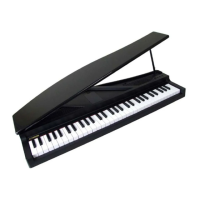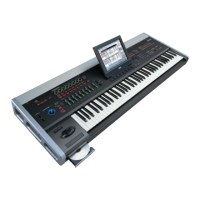Detailed Editing with Programs KARMA settings
63
Quick Start
Introduction
SetupProgram
Combination
Sequencer
SamplingGlobalMediaEffectKARMA
Drum Track
Other
Appendices
KARMA settings
Based on your keyboard playing or on the note data
received from MIDI IN, the KARMA function
automatically generates a diverse variety of phrases or
patterns, such as guitar or keyboard backing riffs, bass
phrases, or drum patterns. You can use the KARMA
sliders and the KARMA switches to freely modify
these phrases or patterns.
The M3 is preloaded with numerous programs and
combinations that cover a wide range of instruments,
performance techniques, and musical styles, and
which take full advantage of the KARMA function.
For more about the KARMA function, please see
page 163.
Drum Track settings
While you perform using a program, you can use the
M3’s rich variety of drum patterns to play high-quality
drum programs.
Playing along with Drum Track patterns is often a
useful way to come up with new phrases.
For more about the Drum Track function, please see
page 185.
Effects
Effects are covered in their own section of the manuals,
so we won’t go into too much detail here.
Insert Effects
Insert Effects let you send either individual Oscillators
or the entire Program through up to 5 effects, in series.
You can use any type of effects, from distortions and
compressors to choruses and reverbs. The Insert Effect
output can be routed to the (MAIN) L/MONO and R
jacks, as well as to each INDIVIDUAL jack.
Two double-size effects (154: St.Mltband Limiter – 170:
Early Reflections) can be used in IFX1–4, plus one
normal effect for a maximum of three effects. You can
also use one double-size effect and up to three normal
effects for a total of up to four effects.
For details, please see “Insert effects” on page 155.
Master Effects
There are two Master Effects, which are accessed
through Sends 1 and 2. The master effects are suitable
for use with effects such as reverb or delay. If you
choose a double-size effect, you’ll be able to use only
one effect in master effect 1. When using a double-size
effect, master effect 2 cannot be used.
For details, please see “Master effects” on page 156.
Total Effect
The Total Effect is dedicated to processing the main L/
R outputs. The Total Effect is suitable for use with
effect types that are applied to the entire mix, such as
compressor, limiter, or EQ.
You can use effects other than double-size effects.
For details, please see “Total Effect” on page 157.
